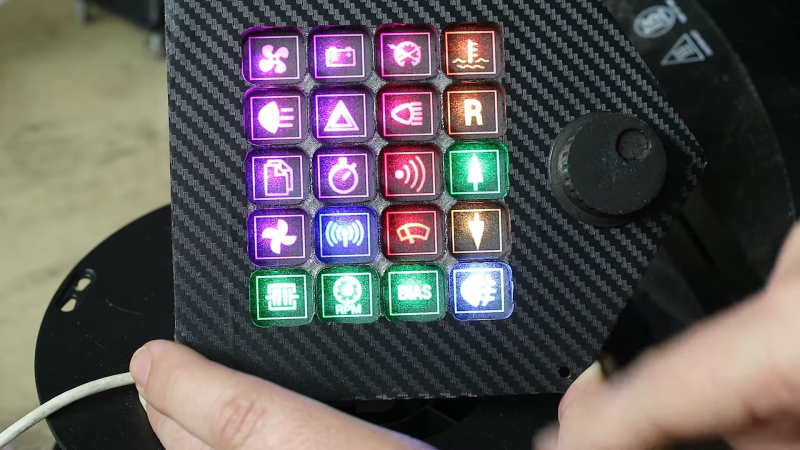A StreamDeck is effectively a really cool box full of colorful buttons that activate various things on your PC. They’re fun and cool but they’re also something you can build yourself if you’re so inclined. [Jason] did just that for his sim racing setup, and he included some nifty old-school tech as well.
An ESP32 is at the core of the build, listening to button presses and communicating with the PC. However, the build doesn’t actually use regular buttons. Instead, it uses infrared sensors wired up in a matrix. This was an intentional choice, because [Jason] wanted the device to be reconfigurable with different paper card overlays. There are ways to do this with regular buttons too, but it works particularly well with the infrared technique. Plus, each button also gets a Neopixel allowing its color to be changed to suit different button maps.
What’s really neat is that the button maps change instantly when a different overlay card is inserted. [Jason] achieved this with an extra row of infrared sensors to detect punched holes in the bottom of the overlay cards.
Once upon a time, even building your own keyboard was an uphill battle. Today, it’s easier than ever to whip up fun and unique interface devices that suit your own exact needs. That’s a good thing! Video after the break.















Neat!
That reminds me of those skins you could slide into a ColecoVision controller to label the game specific hotkeys on the 12-button membrane keypad below the joystick.
That was an over the top controller as console controllers go, given that the default controller had a joystick and 14 buttons and the controller bus was flexible enough to handle even more than that including trackballs (for centipede) and a wheel, gas, and brake controller for the driving games that had a docking bay to use your standard controller as the shift lever.
That was exactly the first thing I thought as well. Glad to see I am not the only one who remembers :)
Pepperidge Farm remembers.
Pepperidge Fahm remembahs.
Can a controller like this be used for automotive applications for fog lights ect.?To create a customized light panel?
I wouldn’t go the infrared “button” route on something exposed to dust, but more importantly, moving shadows from sunlight, like in a moving vehicle.
I remember years ago helping diagnose and intermittently flakey mouse on someone’s PC.
At certain hours of most days the mouse would become jittery and unreliable.
After much cleaning of mouse internals and debugging it turned out the (IR) optical mouse with the cool semi-translucent look was getting interference when the sun was shining on it through the window.
You can easily get any Arduino to read buttons and add a relay module to get stuff going on in your car. As the previous guy said, I wouldn’t use Infrared, but you can use touch or physical buttons. The arduino would mainly allow you to program colours and how they change, otherwise its an overkill as you could just get switches and wire them straight to relays. Some brands make automotive switches with pretty much any logo you can imagine, but if you need one that they don’t make you are out of luck. If you want something fully reconfigurable, you could use a touchscreen, but unless you are electronics/programming friendly or have lots of spare time and will to learn, you are better buying any of the ready made solutions.
Atari 5200, Intellivision, and a few different keypad controllers for Atari 2600 had controller overlays, too. There are probably others that I don’t remember.
It was the thing to do there for a while.
Off subject, I know, but there were even screen overlays for some systems, e.g. Magnavox Odyssey, and Vectrex.
That was meant to be a reply to drenehtsral.
Atari Jaguar. I always wondered why Atari had such a fascination with 10-key pads.
Was the audio for this video synthesized? It sounds very… odd
Yes, it’s elevenlabs TTS.
Puts me in mind of old key maps for PC games before dedicated controllers had more buttons.
I can’t remember the name of the software dad was using in the early 90s but I have vivid memories of him fitting this plastic spiral bound flip-board thing to the top edge of of the keyboard of his work computer. The bottom of each board had additional notes for the one below it.
There were probably a dozen boards, each one color coded with different labels or notes above each of the function keys. I want to say some of them were split so only part of a board would turn over. This thing was pretty big too, easily two inches wide and ran the full length of the keyboard. It wasn’t a standard layout either, he had notes scrawled on or by some of the keys, and they had extra symbols on the sides facing the user.
He was very careful to make sure he always had the right flip-board facing up.
I would like to see a variation of this used with actual push buttons with built-in neopixals used in an automotive application.
Some higher end cars have something similar built in from the factory, but it would be nice to see a custom diy job I could do with my civic.